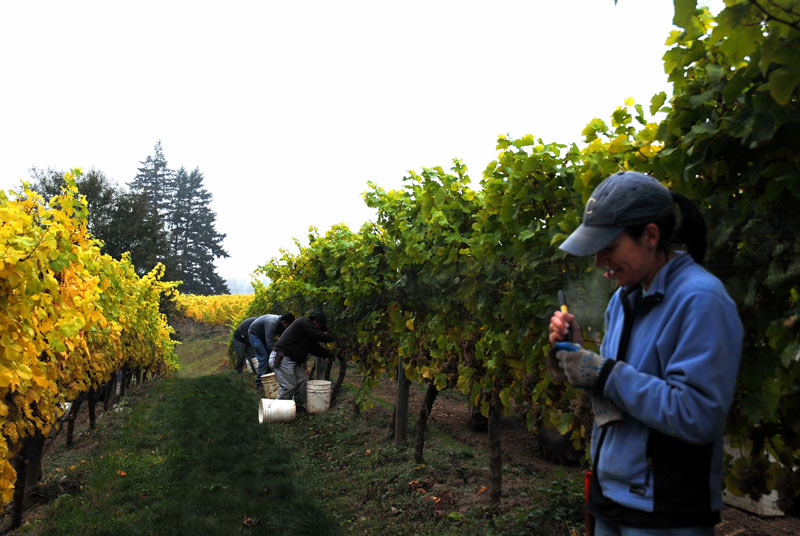The parallels to 1999 are complete for the 2008 vintage. An exceptionally cool growing season ends in full ripening warmth, sun and dryness, giving us possibly one of the best vintages Oregon has seen.
The 1999 vintage saw green fruit at Labor Day, as did this year; cumulative degree day measures of warmth through October 31 of 2043 in 1999 were the lowest we’d seen in the last decade or more–that is, until 2008’s 1977 degree days (average for the last decade is 2228 DDs); with 2.34 inches, rainfall was half-an-inch lower than average for October (2.74 inches) in 1999, but higher than 2008’s 1.66 inches from September 30 through October 30.
The wine quality has yet to be proved, but all signs are that 2008 will be the equivalent to 1999, one of my two or three favorite vintages. But my favorite vintages often aren’t my banker and accountant’s favorite vintages, since in both of these vintages we played it safe by crop thinning to levels of 1.5 tons per acre, to guarantee full ripening if we failed to get good weather — which, of course, Mother Nature perversely gave us.
Our harvest began September 30th and ended October 30th. During those 31 days we took vine development, that at bloom had been three weeks late and had caught up to only two weeks late picking our first fruit, and ended picking Riesling on-time. Although short in tonnage with, for example, a drop from 2.4 tons per acre for Pinot Noir across all vineyards in the prior 5 vintages to 1.9 tons per acre in 2008, the vintage uniformity, depth of fruit, flavors and color, and the disease-free nature of the fruit will be well worth the minimum 25% increase in fruit costs.
Examples of amazingly high quality fruit extend from Pinot Noirs’ fully ripe flavors and colors, but with alcohols in the 13-13.5% range, to Riesling where 23+% sugars and full flavors came with amazingly age worthy 9-10 g/L acids. Look for the same kinfe-edged, white-fruited and ripely-flavored whites and even richer, deeper Pinot Noirs than 2007, a stellar vintage in its own right. There will be less wine available thanks to small crops, but drinking less and better is always good.
And now we begin planning next year, new plantings, possibly cave building, and long trips to warmer climes during the winter.
Regards,
Harry
Weather Today
Rain has finally come, with Friday-on being damp, the leaves electric in color, the mood smug with pleasure that all our fruit has been harvested.
Wednesday and Thursday, dry and gorgeous, saw the final blocks of Riesling harvested with perfect ripeness — moderate sugars, high acids, great flavors!
Harvest to-date
Total:
293 tons
(87% of forecast)
COMPLETE
Pinot Noir: 122.9 tons
(75% of forecast)
COMPLETE
Pinot Gris: 43 tons
(101% of forecast)
COMPLETE
Chardonnay: 103.2 tons
(98% of forecast) COMPLETE
Gruner veltliner: 1 ton
(125% of forecast)
COMPLETE
Riesling: 12.1 tons
(75% of forecast)
Gamay noir: 2 tons
(95% of forecast)
COMPLETE
Pinot blanc: 5.5 tons
(94% of forecast)
COMPLETE

0 Comments
Leave A Comment